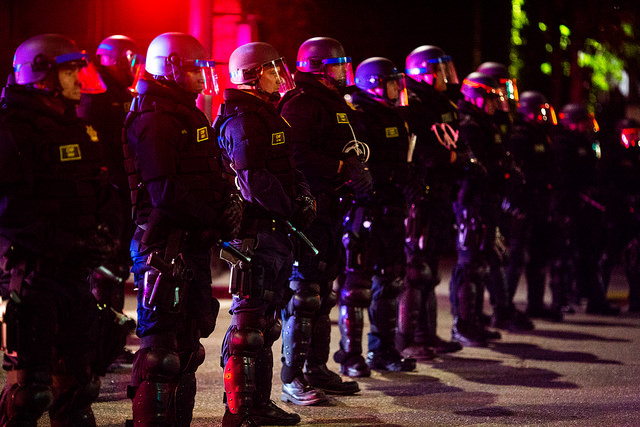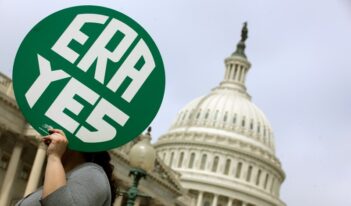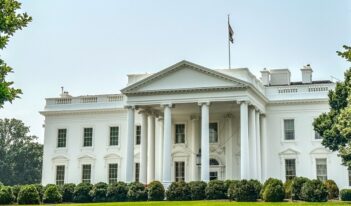
As the debate surrounding police force continues, new practices can address this pressing issue.
As a result of recent high-profile shootings of unarmed African-American civilians by police, the long simmering problem of excessive police force in the United States has sparked a national debate on policing, race, and community relations. As has been the case on repeated occasions in our nation’s history, claims of unlawful or oppressive police practices have focused attention on the powers granted to law enforcement, the use of these powers against racial minorities, political activists, dissidents, and others who challenge the status quo, and on the appropriate remedial mechanisms. And although the great majority of interactions between police and civilians do not involve force or unreasonable force, video-documented incidents of excessive force have moved the debate from one of “is there a problem” to the scope of excessive force, its causes, and effective remedies.
Data collection is still inexcusably deficient in many police agencies, but the data that are available demonstrate patterns of excessive force, as well as large racial disparities in the use of force. A recent study on racial and ethnic disparities in the use of lethal police force from the years 2010 to 2014, by Dr. James W. Buehler of Drexel University, reported 2,285 deaths that resulted from police use of force. The same study found that among males who were 10 years and older, the mortality rate for African-Americans and Latinos was 2.8 and 1.7 times higher respectively when compared with Whites.
Other studies have shown significantly higher rates of shootings among unarmed African-Americans when compared with Whites. In Philadelphia—a city that has approximately 45 percent White, 44 percent African-American, and 14 percent Latino residents—80 percent of force incidents involved African-American suspects, 10 percent involved Latinos, and 9 percent involved Whites.
To be sure, more must be considered before these data can be said to show a causal relationship based on race, since other factors—such as crime rates or the dangers inherent in different suspects’ reactions to police intervention—might explain the racial disparities. However, in related studies involving incarceration rates and stop-and-frisk encounters, non-racial factors have not explained similarly large racial disparities. For example, in litigation surrounding Philadelphia’s stop-and-frisk practices—where the racial data were quite similar to the data on use of force—regression studies have shown that factors such as crime rates, police deployment, and social or economic conditions do not explain the racial differentials in stop-and-frisk practices.
The debate over the causes of unlawful or unreasonable police use of force has focused on the role of (1) law enforcement agencies, in terms of training, supervision, and discipline of officers; in short, on the critical issue of agency and individual accountability, (2) the courts, in terms of remedies that are (or are not) available for excessive force, both to compensate individuals whose rights have been violated and to create a system of remedial measures that have a deterrent effect, (3) civilian review agencies, and the powers of investigation and discipline that should be vested in them, and (4) prosecutors, who have the power to bring criminal prosecutions against officers who engage in the criminal use of force.
Over the years, commentators have documented systemic deficiencies in each of these agencies in controlling and remedying excessive force. In my view, although there is a need for civilian review, litigation involving systemic deficiencies in police policies and practices, and robust judicial oversight, the primary responsibility for developing practices and policies that can ensure effective, equitable, and reasonable uses of force lies with law enforcement agencies. If police departments do not address and “own” the problem, oversight by prosecutors, civilian review boards, and the courts will not provide sufficient counterweights.
Other commentators in this series have shown the reasons why criminal prosecutions, civil rights litigation, and court interventions have not been effective in controlling police violence. Criminal prosecutions are extremely rare as prosecutors must rely on police for the investigation of criminal cases and are reluctant to prosecute officers unless there is overwhelming evidence of serious misconduct. And juries often fail to convict even when the evidence is strong. Civilian review agencies are almost always without sufficient investigative, adjudicative, and disciplinary powers to effectuate departmental changes.
As for judicial intervention, the U.S. Supreme Court, through an application of a series of “judicial door closing” doctrines, has erected numerous roadblocks to effective civil rights litigation. The Court has given an extraordinarily high level of deference to officers who employ force and has interpreted the Fourth Amendment in a manner that only prohibits the most egregious use of force. As Professors Brandon Garrett and Seth Stoughton have commented, “Fourth Amendment case law is not only poorly suited for police training, but [is] actually counterproductive.”
Further, the doctrine of qualified immunity protects officers from damage actions even when their actions have violated the Fourth Amendment, injunctive relief is often barred by standing principles, and except in cases of clear systemic violations of constitutional protections, police departments, municipalities, and states are immune from suit. Although some litigation reform efforts have succeeded—in particular, interventions by the U.S. Department of Justice (DOJ) Civil Rights Division—these initiatives may be in jeopardy with the change in administrations.
So, what is to be done? First and foremost, as Jonathan Smith, the former Chief of the Special Litigation Section of the Civil Rights Division of the DOJ, and others have written, real reform is not possible without the democratization of policing through community participation among those most affected by policing tactics and enhanced transparency in operations. In many ways the police are the least regulated arm of government, notwithstanding their enormous powers. Administrative law principles could be used to require a democratic process of adoption of rules and regulations that control and limit departmental use of force.
Second, police departments must engage in an in-depth review of use-of-force policies and training. For the past 50 years, with the advent of proactive policing characterized by “zero tolerance practices,” aggressive stop-and-frisk policies, and a militarization of police forces, the “warrior” model of policing has become dominant.
However, with the recent attention to excessive force and racial bias, a new debate has emerged, spurred in part by the Black Lives Matter movement. In 2016, the Police Executive Research Forum, a national organization of police officials, issued recommendations on use of force that provide a “guardian” model for policing. These principles stress respect for the sanctity of human life, the need for standards for the use of force that are more restrictive than those imposed by the Constitution, force that is proportional to the dangers of the situation, de-escalation techniques, and fair, transparent, and independent investigations of use of force.
These and other related recommendations were also made by President Barack Obama’s Task Force on 21st Century Policing. The task force emphasized comprehensive data collection as a means towards greater transparency in operations, prioritizing de-escalation tactics, diversity in police ranks, internal accountability, and strong action on racial profiling. These recommendations mirror many of the provisions of consent decrees initiated by the DOJ in its investigative and litigation efforts under its “pattern or practice” authority.
Third, police training must accentuate the need for officers to refrain from escalating tactics and to develop communication and other related skills that can reduce incidents of deadly and other kinds of serious force. Many use-of-force incidents involve mentally ill persons who pose a danger only to themselves. The Washington Post has reported that 25 percent of all fatal shootings by police are of persons suffering from serious mental illness. Police departments should establish “Crisis Intervention Teams” that are trained to respond to these incidents with tactics of patience, deliberation, and de-escalation.
Further, police policies must go beyond the highly deferential constitutional standards announced by the Supreme Court. In a recent case, San Francisco v. Sheehan, the Supreme Court missed the opportunity to adjust constitutional standards to the realities of police use of deadly force. The Court granted qualified immunity to an officer who responded to a report of a mentally disabled woman living in a group home who was threatening to hurt herself with a knife by making an unannounced intrusion into the room in which she was located. When she responded, not surprisingly, by moving towards him with the knife, he fired several times.
Notwithstanding universal agreement among policing and psychology experts that an officer in these encounters should not enter barricaded rooms and that trained negotiators should be called to de-escalate the tension, the Court determined that no clearly established Fourth Amendment rights had been violated because the officer faced the threat of serious bodily injury when he used deadly force. But if “reasonableness” is the touchstone of the Fourth Amendment, why would the Court credit the decision to use deadly force as one made in a “split-second” context and ignore the officer’s responsibility in creating the danger?
Fourth, officers should be provided with less-than-lethal equipment such as safe chemical sprays and electronic control weapons like tasers—along with comprehensive training and supervision—that can be used when resistance is serious but not life-threatening, and the suspect can be safely secured without deadly force.
Fifth, to ensure proper accountability, internal investigations must be conducted with integrity, provide appropriate discipline and retraining when fault has been found, and implement a high level of transparency surrounding investigative information and decision-making. Investigators must also recognize the deleterious effects of the police “code of silence” on their adjudications. All too often, lack of accountability leads the offender and other officers to assume that breaking the rules has no consequences.
Sixth, departments must expand the use of technology that promotes accountability and transparency. Many of the recent controversial use-of-force incidents became known only through police body-worn and surveillance cameras, as well as cell phone videos. All departments should be moving to universal body and patrol car cameras, with regulations that require that these cameras function at all critical stages of police-civilian interactions.
Seventh, more attention must be paid to explicit and implicit racial bias. This concern cuts across hiring, training, and supervision of officers and should incorporate the new advances and learning with respect to the phenomenon of “implicit bias,” which relates to how unconscious attitudes and perceptions may alter a person’s view and understanding of other people’s conduct and actions. For police, this is especially important in their assessment of the dangers posed by civilians, and in particular suspects who may pose a risk of physical danger to the officer.
There is experiential evidence of the effectiveness of new paradigms and cultures of policing. For example, due to concerns about the levels and patterns of force by officers in the Philadelphia Police Department, former Philadelphia Police Commissioner Charles Ramsey requested a study by the DOJ on the Police Department’s policies, training, and investigations of use of force. The study produced a wide-ranging set of recommendations that were soon implemented by the Philadelphia Police Department. More time will be required before definitive conclusions can be drawn, but it is instructive that use-of-force patterns in Philadelphia appear to have changed in significant ways. Thus, comparing data from 2012 with 2015, the Philadelphia Police Department reported the following:
| 2012 | 2015 | |
| Number of police shooting incidents | 59 | 35 |
| Number of shots fired at civilians | 477 | 200 |
| Persons killed by police | 16 | 2 |
| Persons injured by police | 32 | 15 |
| Number of officers firing at persons | 104 | 46 |
The renewed debate on police use of force provides an opportunity to correct both the constitutional and operational standards in an area that poses fundamental challenges to our commitment to restraints on necessary—but widely abused—governmental powers.
This essay is part of a fifteen-part series, Regulating Police Use of Force.




